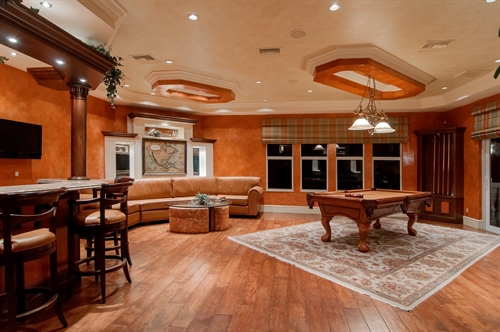A living room has a variety of functions within a household. It may act as a space for entertaining, for playing games or for watching TV. It might be a room for children to play in, or an adults-only space.
Make a focal point
Some rooms have a natural focal point in the form of a fireplace or a window – but if that’s not the case in your living room, consider making a feature wall, either with wallpaper or with pictures or a decorative display.
A family photo wall can be an effective way to personalise your room and create a focal point; or a display of anything that is meaningful to your family. Other people prefer to display the books they love best, or items that represent a hobby or activity that is important to them.
Suitable storage for your living room
Good storage, like baskets, ottomans and cupboards, will help you to keep your living room tidy, uncluttered and inviting. A daily five-minute tidy can make all the difference in the world, and this task is much easier if everything has its place in your living room.
Discourage family members from using the living room to store sports equipment, outdoor clothing, work clothing or items they don’t want to keep in their room. Instead, find space for these in other parts of the house so they can be put away out of sight.
A media ready space
For some families, entertainment – whether TV, music or video games – is the main activity in the living room.
Take time to get your set-up right to ensure seating is comfortable and that the sound works well in every part of the room. Consider carefully the size of TV that is right for your room – a massive screen might seem desirable – but will it dominate the space?
It’s worth getting advice from an audio-visual expert to ensure your entertainments set-up meets your needs. Currys has some articles on various AV set-up issues, including how to get a soundbar up and running.
Consider media storage: how much space do you need; and is it important to see all your media collection, or do you prefer to hide it away behind cupboard doors. Or you might want to start converting to streaming media to save space.
Check that the living room door shuts properly so that people watching or listening don’t disturb others; and to make sure that noise from other parts of the house doesn’t interfere with TV, gaming or music.
Room for reading
A warm and comfortable reading space could help you to avoid doomscrolling. Look for a comfortable spot with good lighting – or get hold of a reading lamp to make your books even more enjoyable. Treat yourself to a magazine subscription to ensure you’ve always got something interesting to hand.
Scented space
Our sense of smell has an effect on our emotions, and calming or comforting scents can set the scene for relaxation. Diffusers or scented candles are one way of achieving this, as are room sprays and fresh flowers or scented plants.
Defining areas in your living room
When a space is shared by several family members, or if it has several distinct functions (for example, playing music, reading and watching TV), try using rugs to create zones within your living room.
Change with the seasons
From time to time, change out your living room. A space that is cosy and warm in the winter can seem dark and stuffy in the summer. So switch out woolly textiles and dark colours for fabrics that are lighter in colour and cool to touch.
A window that is pleasantly sunny in winter can leave your room unusable in summer unless you fit shades or blinds, so consider cooling as well as heating when designing your living room.
Putting out-of-season rugs and loose covers into storage will allow you to adapt your space to the weather, making your living room inviting all year round.
Decluttering your living room
All domestic goods – including blankets, cushions and curtains – are included in your self-storage insurance policy with Store and Insure. Get a quote today to see if you can save money on your self-storage insurance.


